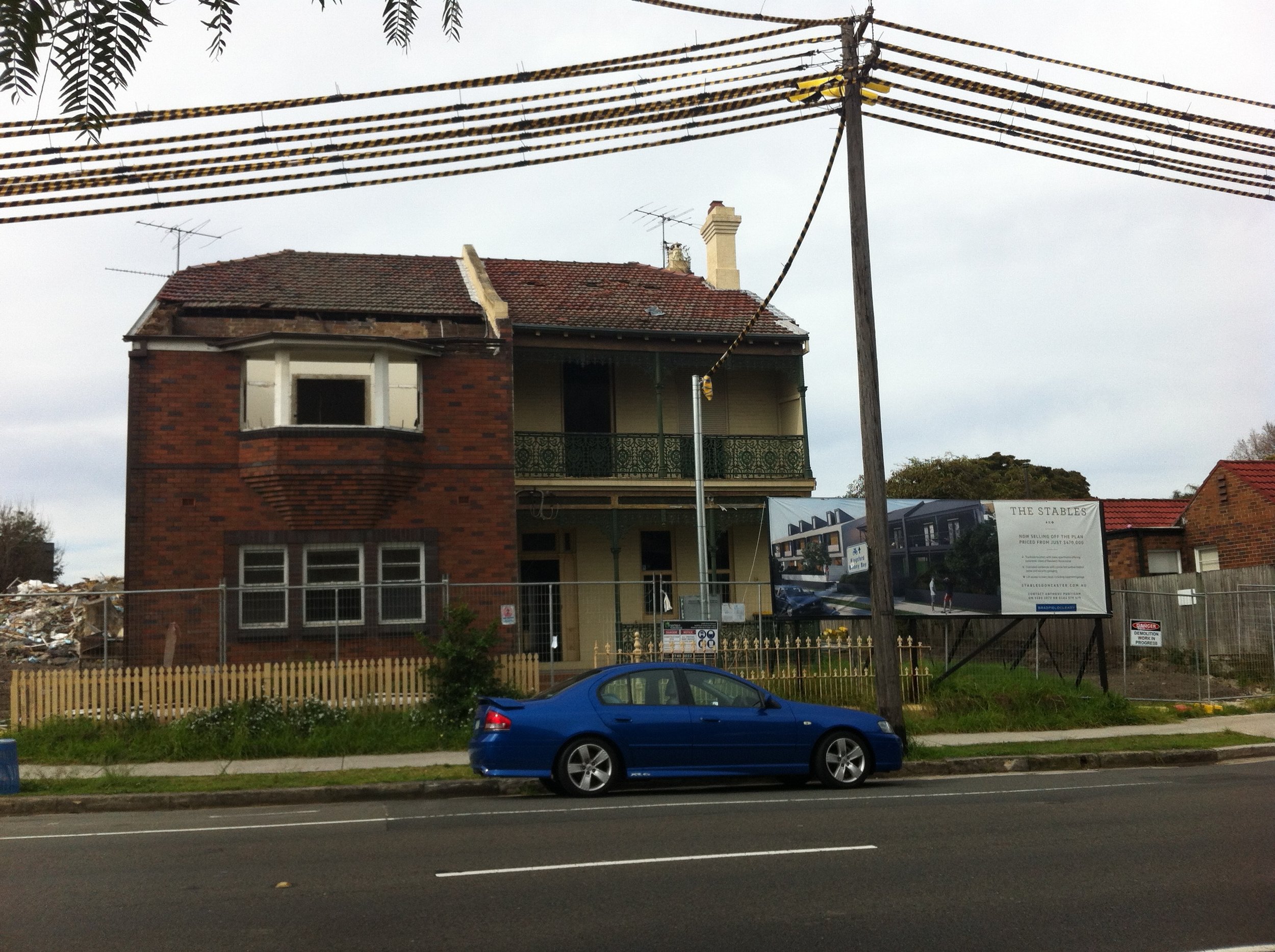With Age Comes Wisdom // Adaptation & Reuse
As dreary as this building appears at the moment,
it yields sustainable potentials (Chan, 2014).
Not unlike one of my early posts in March (Tear it Apart), I was once again struck by the apparent waste and visual destruction at another construction site near my home in Kensington. This however was very visually different, for two terrace houses stood, hollowed out but nonetheless appeared to be retained in the future low-rise apartment complex known as The Stables.
The Stables - the two restored terrace houses, with the adjacent new development. (The Stables Doncaster, 2014).
While it could very easily be argued that the terrace houses should be demolished to make way for the rest of the modern, contemporary structure, architects Fox Johnson have instead opted to retain the existing fabric. Already a move to reduce waste, the design combines a mix of the apartment and terrace typologies (The Stables Doncaster, 2014), reducing the overall embodied energy of construction. There is of course room for improvement in the approach, such as better consideration of waste and architecturally a more significant linkage between the old and new fabrics but the willingness to preserve existing fabric, regardless of whether this has been dictated by heritage laws or council requirements is to be applauded.
Formerly The Mint and now home to the Heritage Trust - a perfect merger of old and new structures (FJMT, 2014).
Similarly, one of the most significant adaptive interventions of Sydney has been the highly praised Royal Mint Buildings for the Heritage Trust. New insertions are “carefully modulated so as to cause little conflict with the historical context” (Architecture AU, 2013). Here again, I believe we see that there is a growing need to alter our existing fabric to fit into the modern age rather than our materialistic habit of simply discarding and starting anew constantly. Despite the truth that such designs may prove to be more expensive than tearing down our cities and rebuilding them with ‘better’ environmental systems, our cities are not a tabular rasa for a complete restart and require careful interventions to improve them.
Winner of the 2013 Royal Institute of British Architects Stirling Prize - an example of how new intervention can be
situated within the old, without having to start anew or destroy existing fabric. (Dezeen, 2013).
Indeed the 2013 Royal Institute of British Architects Stirling Prize was awarded to a project which focused on adaptation, integration and reuse. Originally a 12th Century ruin, Astley Castle has been renovated into a small but luxurious residence. Introducing brickwork and timber generates a “discreet relationship between the exterior sandstone walls and the addition” (Grozdanic, 2013) which also stabilises the old castle ruins and offers a source of new interpretation. As the jury statement describes, Astley Castle successfully “places the new building at the heart of the old”, thus creating an engaging experience between stone, masonry and timber. In terms of sustainability, the decision to incorporate existing structure, despite its severely dilapidated state offers insight into how architects may be able to create great architecture, with small, careful incisions. Indeed the success of Astley castle relies on the “visible contrast” between the clay brickwork infill and the historical sandstone (Dezeen, 2013).
Overall, these three projects represent a reassuring trend in the design profession, where ‘newness’ is not necessarily the most valuable component. Our attempts to reuse old fabric in innovative ways will successfully reduce the embodied energy of our buildings while creating meaningful and valuable works of architecture. For me personally, the ability to merge the old and new represents not only a triumph in sustainable design but also a fineness and grasp of the complexities in design.
Resources
Dezeen. “Astley Castle Renvovation by Witherford Watson Mann”. (20 July 2013). Retrieved 20 May 2014 from: http://www.dezeen.com/2013/07/20/astley-castle-renovationby-witherford-watson-mann/
Royal Institute of British Architects. “2013 RIBA Stirling Prize Winner – Astley Castle, Warwickshire”. (2014). Retrieved 20 May 2014 from: http://ribastirlingprize.architecture.com/riba-stirling-shortlist-2013-astley-castle-warwickshire/
Lidija Grozdanic. “Decaying 12th Century Astley Castle Scoops 2013 RIBA Stirling Prize for Best New Building”. (27 September 2013). Retrieved 20 May 2014 from: http://inhabitat.com/decaying-12th-century-astley-castle-transformed-into-a-modern-hotel-in-england/
The Stables Doncaster. “The Residences”. (2014). Retrieved 20 May 2014 from: http://stablesdoncaster.com.au/
FJMT. “The Mint – Historic Houses Trust, Sydney”. (2014). Retrieved 20 May 2014 from:
http://www.fjmt.com.au/projects/projects_mint.html
Architecture AU. “Lachlan Macquarie Award fro Heritage”. (2013). Retrieved 20 May 2014 from:
http://architectureau.com/articles/lachlan-macquarie-award-for-heritage-5/









